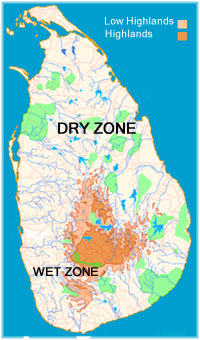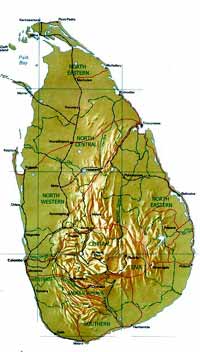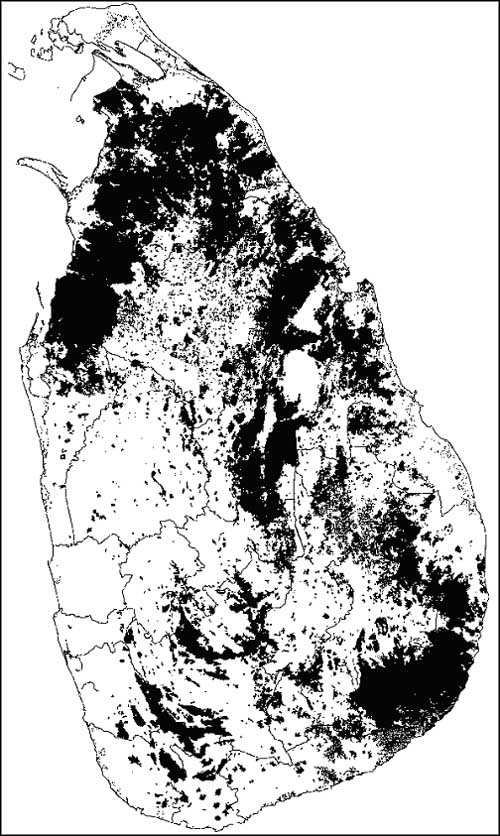


Sri Lanka is the country with the highest species richness in the world and home to several forest eco regions. The southwest portion of the island, where the influence of the moisture-bearing southwest monsoon is strongest, is home to the Sri Lanka lowland rain forests. At higher elevations they transition to the Sri Lanka montane rain forests.
The northern and eastern portions of the island are considerably drier, lying in the rain shadow of the central highlands. The Sri Lanka dry-zone dry evergreen forests are a tropical dry broadleaf forest ecoregion, which, like the neighboring East Deccan dry evergreen forests of India's Coromandel Coast, is characterized by evergreen trees, rather than the dry-season deciduous trees that predominate in most other tropical dry broad leaf forests.
Forests at one time covered nearly the entire island, but by the late twentieth century lands classified as forests and forest reserves covered only one-fifth of the land. The southwestern interior contains the only large remnants of the original forests of the wet zone. The government has attempted to preserve sanctuaries for natural vegetation and animal life, however. Ruhunu National Park in the southeast protects herds of elephant, deer, and peacocks, and Wilpattu National Park in the northwest preserves the habitats of many water birds, such as storks, pelicans, ibis, and spoonbills. During the Mahaweli Garga Program of the 1970s and 1980s in northern Sri Lanka, the government set aside four areas of land totalling 190,000 hectares as national parks.
Temperate and Boreal Forest Types of the World
1 Evergreen needleleaf forest
Natural forest with > 30% canopy cover, in which the canopy is predominantly (> 75%) needleleaf and evergreen.
2 Deciduous needleleaf forest
Natural forests with > 30% canopy cover, in which the canopy is predominantly (> 75%) needleleaf and deciduous.
3 Mixed broadleaf/needleleaf forest
Natural forest with > 30% canopy cover, in which the canopy is composed of a more or less even mixture of needleleaf and broadleaf crowns (between 50:50% and 25:75%).
4 Broadleaf evergreen forest
Natural forests with > 30% canopy cover, the canopy being > 75% evergreen and broadleaf.
5 Deciduous broadleaf forest
Natural forests with > 30% canopy cover, in which > 75% of the canopy is deciduous and broadleaves predominate (> 75% of canopy cover).
6 Freshwater swamp forest
Natural forests with > 30% canopy cover, composed of trees with any mixture of leaf type and seasonality, but in which the predominant environmental characteristic is a waterlogged soil.
7 Sclerophyllous dry forest
Natural forest with > 30% canopy cover, in which the canopy is mainly composed of sclerophyllous broadleaves and is > 75% evergreen.
8 Disturbed natural forest
Any forest type above that has in its interior significant areas of disturbance by people, including clearing, felling for wood extraction, anthropogenic fires, road construction, etc.
9 Sparse trees and parkland
Natural forests in which the tree canopy cover is between 10-30%, such as in the steppe regions of the world. Trees of any type (e.g., needleleaf, broadleaf, palms).
10 Exotic species plantation
Intensively managed forests with > 30% canopy cover, which have been planted by people with species not naturally occurring in that country.
11 Native species plantation
Intensively managed forests with > 30% canopy cover, which
1 Evergreen needleleaf forest
Natural forest with > 30% canopy cover, in which the canopy is predominantly (> 75%) needleleaf and evergreen.
2 Deciduous needleleaf forest
Natural forests with > 30% canopy cover, in which the canopy is predominantly (> 75%) needleleaf and deciduous.
3 Mixed broadleaf/needleleaf forest
Natural forest with > 30% canopy cover, in which the canopy is composed of a more or less even mixture of needleleaf and broadleaf crowns (between 50:50% and 25:75%).
4 Broadleaf evergreen forest
Natural forests with > 30% canopy cover, the canopy being > 75% evergreen and broadleaf.
5 Deciduous broadleaf forest
Natural forests with > 30% canopy cover, in which > 75% of the canopy is deciduous and broadleaves predominate (> 75% of canopy cover).
6 Freshwater swamp forest
Natural forests with > 30% canopy cover, composed of trees with any mixture of leaf type and seasonality, but in which the predominant environmental characteristic is a waterlogged soil.
7 Sclerophyllous dry forest
Natural forest with > 30% canopy cover, in which the canopy is mainly composed of sclerophyllous broadleaves and is > 75% evergreen.
8 Disturbed natural forest
Any forest type above that has in its interior significant areas of disturbance by people, including clearing, felling for wood extraction, anthropogenic fires, road construction, etc.
9 Sparse trees and parkland
Natural forests in which the tree canopy cover is between 10-30%, such as in the steppe regions of the world. Trees of any type (e.g., needleleaf, broadleaf, palms).
10 Exotic species plantation
Intensively managed forests with > 30% canopy cover, which have been planted by people with species not naturally occurring in that country.
11 Native species plantation
Intensively managed forests with > 30% canopy cover, which
 ශිල්ප 64
ශිල්ප 64